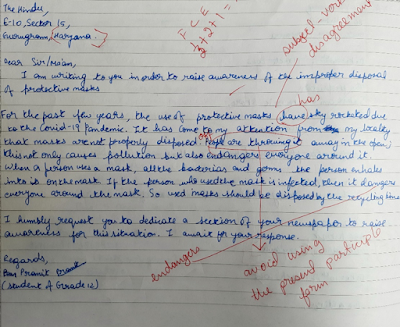Lexical and Semantical Errors
One major common
error detected is wrong word choice, and erroneous use of words in sentences which
introduces confusion, leading to repetition of ideas and for that effect long,
run-on sentences. In times when brevity and conciseness play an important role in
written expression, students display a poor grasp of vocabulary and word choice.
One of the possible reasons for this is that students are probably voicing
their ideas in written form. The harsh fact is that there is a difference
between verbal and written expression which needs to be addressed at an early
formative stage of the child’s learning years. Having a good vocabulary can
make a big difference not just in written expression, but also in verbal
communication. The wrong use of a word can alter the meaning of the entire
sentence drastically. A person with a
good knowledge of words has a good command of the language and this is an
important social skill. Entrepreneurs, managers, content writers, and motivational
speakers, all of them have a very good repertoire of words.
Please look at figure 1 and 5 in the index as examples.
Suggested
Solutions
Encouraging students
to read extensively will help them enhance their vocabulary and understanding
of word usage. Having a well-stocked library, library periods, and
documented reading sessions in the library can help a great deal. In fact,
encouraging students to read extensively will help firm up their written
expression in terms of Lexical Semantics as well as Syntactical skills. The
library should have books based on Lexile scores and difficulty levels. Library
periods should be allotted to students of all grades from eight to twelve.
Syntax Related
Errors
It has also been
noticed that students throughout grade levels have a poor grasp of the rules of
grammar. Some of the glaring examples include subject-verb disagreement,
clashing tense usage (where students mix the present tense with the past tense)
the use of the indefinite form of ‘will’ in future tense constructions. Poor
knowledge of sentence type, use of simple sentences, and inability to use
coordinating and subordinating conjunctions leads to excessive repetition, run-on sentences and overall inability in conveying content within the specified
word limits. Another common error noticed amongst a large number of students
deals with the excessive use of the present participle form of verbs (the
ing-form). One glaring common error in written English deals with the use of
the active voice in formal/official communications like notices and notes of
regret or acceptance of invitations. Students very often make errors in
reporting speech. While quoting entire phrases is alright, it however cannot
exclude paraphrasing. We have introduced research/thesis papers and term papers
at some grade levels which is why having a strong grasp of rules for converting
direct speech is an important skill that needs to be nurtured in our students.
Surprisingly, another glaring common error noticed in our students is a lack of
consistency in the use of correct punctuation marks and correct capitalization of
proper nouns.
Please look at Figure 3 as an example of subject-verb disagreement,
incorrect use of the present progressive form of a verb and avoidable use of
the present participle.
Suggested
Solutions
Students need to be
taught formal rules of grammar from the early grades. Our workbooks should have
exercises that offer students enough practice in the correct use of rules of grammar.
These worksheets should have exercises dealing with tense forms, joining of
clauses using conjunctions, demonstrative pronouns and adjectives, and relative
pronouns will all help reduce confusion in expression and help reduce
repetition of ideas. Students need a lot
of practice in converting active voice sentences into passive voice form
and vice versa. We need to have a lot of exercises dealing with the conversion
of direct speech into reported speech.
Issues Related to Neatness of work and Neatness
of Handwriting
While it is true that
we have started depending on smart devices like laptops and iPads for
submissions of assignments and projects, the harsh fact is that students must
write their answers in the two summative board exams of the CBSE so that they
can be checked by an examiner. Unfortunately, if the examiner is not able to
decipher what has been written in the answer sheet, then he or she will not
award marks. Marks awarded for Literature short answers and long answers are
further divided into content, grammar and expression. Handwriting impacts the
total marks given for expression. Writing is an important skill that needs to
be nurtured from the early years of a child. My experience in checking board
papers and working as a head examiner shows that students who write neatly and
legibly tend to score better marks than others who although they better
understanding might not fare so well because of their untidy presentation and
illegible handwriting.
Please check figure 2 in the index as an example of what I mean by poor
handwriting. I took up this particular case with the parents at the beginning
of grade 12 when we started physical classes. Fortunately, what you see is a
major improvement.
Observations:
Higher-order writing
skills can be taken up only after we address errors and inconsistencies in
Lexical-Semantical and Syntactical expression. While the CBSE has moved from
the teaching of formal grammar to the teaching of grammar through the
communicative approach, it has been observed over a period of time that this
has not translated into fluent written expression. We need to, therefore,
resort to the teaching of formal rules of grammar and expression as a remedial
process. These observations are based on corrections of the grade 12 Pre-Board
II papers of English. There needs to be a vertical alignment of standards
across all grade levels starting from grade four to grade twelve if we really
want to address common errors in written English in our students. I have
observed that quite a few students grasp their pens wrongly. A stiff wrist and
wrongly held pen can affect not just the quality of the writing but also
impacts the speed of writing. If we have written exams, it is very important
that we focus on teaching children to write in a legible hand. The students
whose samples have been given in the index were guided for two years and their
errors have been constantly pointed out to them. While some of the errors might
be blamed on the Covid-19 outbreak and the emergent lockdowns that forced
students and teachers to resort to online teaching platforms, the entire blame
cannot be laid on the circumstances. If students in grades eleven and twelve
have moderate skills in written English, then we need to tackle this problem
from the early classes. Some form of enrichment classes that cater to semantic
and lexical skills could be introduced into the curriculum from the earliest
classes in the Senior Program. Grades eight, nine and eleven are crucial
classes where corrective measures can be taken up. Grades ten and twelve
already have a lot on their plates so, I guess it would be a good idea to
launch a pilot project in grade eight and nine, and then grade eleven. One
meeting in a cycle of six days of fifty minutes should suffice.
Index
A few examples of
commonly found errors are posted below. These include lexical errors,
syntactical errors, and of course examples where the handwriting is indecipherable,
or the work is so untidy that not much can be made out of what has been written
by the student.
 |
| Figure 1- incorrect word choice and wrong use of 'will' |
 |
| Figure 2This is an example of a handwriting that is not very readable. |
 |
Figure
3 A typical example of subject-verb disagreement. |
 |
Figure
4 A typical example where the proper use of a pronoun could have
avoided repetition. |
Figure
5 A typical example of a semantic error, and an error of redundancy.




































